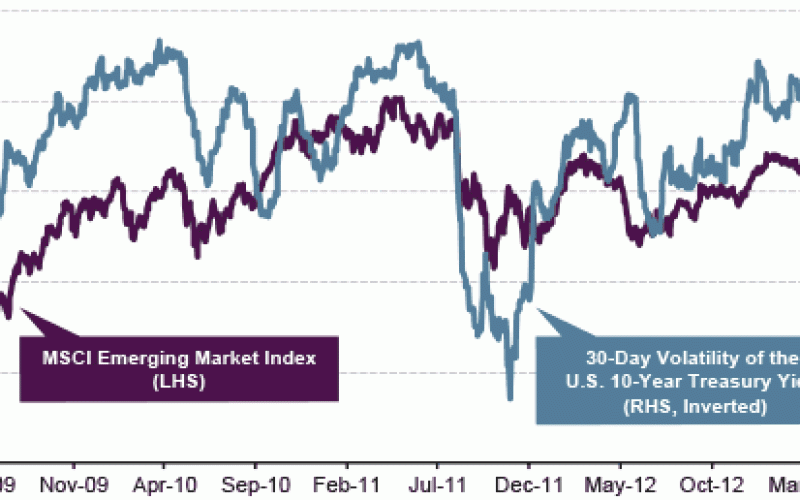October 23 2013
Ultra loose U.S. monetary policy continues pushing asset values higher at home and abroad. Seasonal factors should also provide a tailwind and lift asset prices across nearly every investment class.
by Scott Minerd, Global CIO, Guggenheim Partners LLC
Since the Federal Reserve surprised investors in September by announcing it was not about to start tapering its asset purchases, nearly all financial markets have been in risk-on mode buoyed by the promise of continued easy money. Recent economic data, such as the relatively weak September employment report, has been supportive of continued monetary accommodation. In light of this, the Federal Reserve will likely hold off on tapering until the second quarter of next year.
Interest rates have declined steadily since mid-September, when Chairman Ben Bernanke re-affirmed the Fed’s commitment to monetary accommodation, and have room to fall another 50 basis points before reaching a bottom. Declining interest rates should boost housing activity and should contribute positively to economic growth by the first quarter of 2014.
Fixed-income assets have also benefitted from the decline in interest rates. Relatively low levels of new supply and seasonally elevated fund flows will likely contribute to further spread compression. Domestic stocks are also receiving a boost from the higher volume of flows. The NYSE Advance/Decline line recently broke to the upside, supporting the view that now is a solid entry point for U.S. equities, which should continue to see gains through the balance of 2013.
Lower U.S. Treasury yields and the flood of liquidity from the Fed should continue supporting growth throughout the rest of the global financial system. European stocks are cheaper than U.S. equities, having further room to appreciate. Asian equities should also benefit from the Chinese government’s renewed commitment to keeping its target economic growth rate on track despite structural problems in its economy. Overall, an increasingly bullish outlook has taken hold across nearly all geographies and asset classes, making now an ideal time to put money to work.
Chart of the Week
Emerging Market Equity Rebound Should Continue as U.S. Interest Rate Volatility Declines
Historically, emerging market equities have been closely correlated with the volatility of the U.S. 10-year Treasury yield, as periods of rising volatility are usually associated with the occurrence of major macro risks, which in turn puts downward pressure on emerging market equities. Following the delay of tapering of asset purchases by the U.S. Federal Reserve and the temporary resolution of the U.S. debt ceiling and budget battles in Washington, the U.S. 10-year Treasury yield has stabilized. With the volatility on the 10-year yield falling to the lowest level since May 2011, the current rebound in emerging market equities could continue.
MSCI EMERGING MARKET INDEX VS. 30-DAY VOLATILITY OF THE U.S. 10-YEAR TREASURY YIELD

Source: MSCI, Bloomberg, Guggenheim Investments. Data as of 10/23/2013.
Economic Data Releases
Payroll Growth Stumbles in September
- September non-farm payrolls rose 148,000, forecasts saw gains of 180,000. Positive revisions to August payrolls were largely offset by downward revisions to July.
- The unemployment rate fell for a third straight month to 7.2% due to a solid household employment number.
- Average hourly earnings inched up 0.1% in September and average weekly hours were unchanged.
- Existing home sales fell to an annualized pace of 5.29 million in September, a 1.9% drop. August home sales were revised down, resulting in two consecutive months without growth in existing home sales.
- Construction spending increased 0.6% in August, the fifth straight monthly gain.
- The FHFA House Price Index rose 0.3% in August, the lowest growth since September 2012.
- Mortgage applications fell 0.6% for the week ended October 18 on decreased refinance applications, but purchase applications rebounded after falling for the past three weeks.
More Confidence in Europe, Chinese Growth Rebounds
- Euro zone consumer confidence rose for an 11th straight month in October, increasing to -14.5.
- Business confidence in France ticked up to 98 in October, returning to the highest level in the current recovery.
- As expected, China’s third quarter GDP rebounded to 7.8% annual growth, the fastest pace this year.
- Chinese industrial production grew 10.2% year-over-year in September, slowing slightly from August’s 17-month high.
- Retail sales growth in China inched down in September from 13.4% to 13.3% from a year earlier.
- Japanese export growth slowed to 11.5% year-over-year in September, below expectations of 15.6% growth. Shipments to all major regions slowed.
Copyright © Guggenheim Partners LLC














